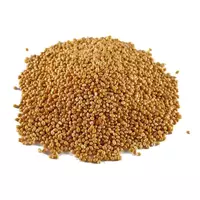Grain sorghum

Grain sorghum is considered one of the most important feed, technical and food varieties of the plant of the same name. Sorghum or Sorghum belongs to perennial cereal plants from the Myatliky family. Currently, there are about half a hundred species of sorghum that grow everywhere in Africa, Asia, as well as on the American continent, in Europe and in Australia.
Some varieties of sorghum, including grain, are grown as an agricultural crop. Researchers believe that Ethiopia, and besides Sudan, can be considered the birthplace of grain sorghum. It is also worth emphasizing that sorghum grain is considered one of the oldest cereal crops that people began to cultivate back in the ancient period of the development of human civilization.
Archaeologists have found reliable evidence that sorghum was grown in India as early as the 3rd millennium BC. In Europe, grain sorghum, like other varieties of the plant, was brought by Spanish conquistadors, who in the 15th century began the process of developing new lands. In its biological structure, sorghum grain is a Japanese crop that is heat-loving.
In addition to sorghum, grain can tolerate drought perfectly. The uniqueness of such a cereal as sorghum grain lies in the fact that the plant is able to grow in various types of soil. Grain sorghum or Sorghum bicolor belongs to herbaceous plants from the Cereal family. Sorghum grains are cultivated on an industrial scale in China, as well as Japan and Korea.
Cereal or flour is produced on the basis of grain sorghum. In addition, the stem of the plant is used to harvest hay or silage, which are fed to pets. It is worth noting that in China, a national drink is made from sorghum grains, which is similar in its taste and consumer characteristics to Russian vodka.
Currently, three main varieties of grain sorghum are distinguished:
Sorghum bicolor bread sorghum or milo;
Sorghum bicolor nothosubsp. drummondii or Sudanese grass;
Sorghum bicolor subsp. verticilliflorum.
Experts often compare the distinctive characteristics of grain sorghum with other famous and oldest cereal plants of corn. As it turned out, sorghum grains contain much more protein and protein of natural origin than corn. Besides, grain sorghum is enriched with vitamins of groups A and B, and also contains tannins.
It is also noteworthy that the chemical composition of grain sorghum contains a fairly large amount of starch-containing compounds. For this reason, it is on the basis of grain sorghum that starch is produced, which is used in the drinking industry.
It is also interesting that starch obtained from grain sorghum is used not only for culinary purposes. but also in such industries as textile, paper and mining. In addition, grain sorghum starch is actively used in pharmacology.
grain sorghum 323.1 kCal
Energy value of grain sorghum (Ratio of proteins, fats, carbohydrates - ju):
Proteins: 11.1 g (~ 44 kCal)
Fats: 3.3 g (~ 30 kCal)
Carbohydrates: 66.4 g (~ 266 kCal)
Energy ratio (b | y): 14% | 9% | 82%
 Español
Español Français
Français Português
Português Русский
Русский 简体中文
简体中文 繁體中文
繁體中文 日本語
日本語 한국어
한국어 العربية
العربية Türkçe
Türkçe Қазақ
Қазақ Deutsch
Deutsch Italiano
Italiano Українська
Українська
